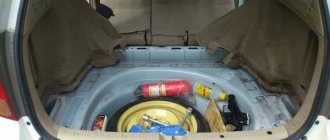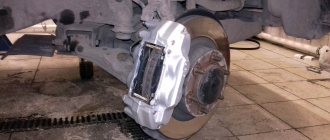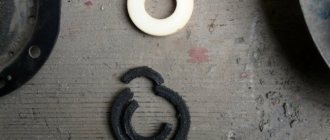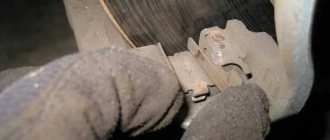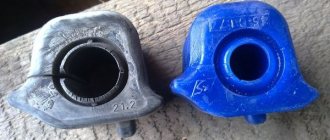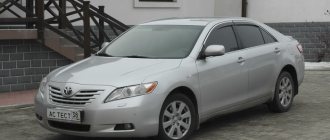Cars admin26.02.2020
Good day.
The time had come to replace the rear struts... The original struts were wet... they didn't hold well (I swung both struts effortlessly by the trunk with one hand)... it was especially noticeable when starting at a traffic light, because... Korollka’s stern was pressed against the asphalt, probably from the outside it looked like a motor boat starting from a place on the surface of the water...))) There really weren’t any knocks from them...)
I ordered Kayaba 341 816 rear suspension shock absorbers from the supplier SMAR through Emex, it cost 5,628 ₽
Yesterday we went to the dacha, and replaced them there... The tools I needed were spring ties, I used the most common ones, for the front and rear springs...
Keys: ring “19”, “17”, a pair of open-end “17” for ties, heads for “14”, “19” with a large ratchet, and a small ratchet with a hexagon for “6” (since the usual “G” the "-shaped hexagon could not withstand the load and was twisted around its axis), and a couple of pipe extensions (since the nuts did not want to come off the rod), a WD-shackle...
To remove the strut: remove the trunk trim and immediately tear off the nut on the shock absorber rod, put a hexagon into the end of the rod and a socket on “17”...
Then a couple of nuts from the interior, one “14” bolt from under the arch...
And lastly, unscrew the lower nut securing the rear shock absorber from the rear beam, using a socket or socket on “19”...
Then we just take out the strut... then I pulled off the spring...
I completely tightened the nut on the rod, disassembled the rack and washed everything from dirt... I pumped the new racks without turning them over, and put everything back together as it was...)
I didn’t paint the glasses, and I didn’t have anything to do it with at the dacha... I washed them with WD as much as I could, and smeared the surface of the glasses adjacent to the body with green Castrol LMX LI Komplexfett lubricant, so that less rust would eat into both the body and and into the glass... And the stand into place...
After screwing the rack to the body, I did this: the rack in place, the lower nut fastening to the beam in place, put the wheel on, and lowered the car to the ground... I shook the body in all directions with my hands, then tightened the inner two nuts securing the glass while the car was standing, again the car on the jack, threw the wheel off again and lastly screwed on the last bolt of the cup from under the arch... I lubricated all the threads with the same green grease... The second side is the same. ...)
I drove back with the same smile and a sense of accomplishment...) Now the “butt” of the car is elastic, it doesn’t squat at the start, it began to take turns even better (and the changes were felt even when I just replaced the front struts, now it’s absolutely beautiful), knocking no matter how it was, it was not possible to swing the Korollka’s stern using the trunk with one hand...)))
The next replacement of the first lambda, the infection eats like Kamryukha one to one at 15 liters per hundred square meters in the city...) only there is an internal combustion engine 2.4, and here it is 1.6...)))
Thank you for your attention, good luck to all of you on the roads.
see also
Comments 12
Hello. Have you already replaced the lambda or is it still in the process?
Hello... Not yet... While I just can’t bring myself to throw away almost 5 rubles on this small spare part...))) But I haven’t given up on the planned replacement yet...) Most likely in the future. month to replace it...
It’s clear, I just changed it to a used one after parsing it, but I didn’t notice any special effect. Will it be any good with a new one out of the box?)))))
who the hell knows... but I know for sure that the Corolla with a 1.6 internal combustion engine has an appetite, exactly the same as on the Kamryukha where the volume is 2.4...)) and the check does not light... i.e. The lambda turns out to be working, but gives incorrect readings, either because it is clogged with fumes (or whatever happens to them), or is simply tired from time and has not died completely yet... in short: it does not work correctly...) I have no options, Definitely change it... but only for a new one, since if you buy a used one, God knows, maybe it’s just as working, it will come across wrong...)
Anything is possible. I just don’t have a modest appetite, especially in winter. In the summer, more or less. Okay, we're waiting for the report)))
Hello, I hope you didn’t throw away the old stands? You need to measure the lower landing diameter, otherwise I bought the struts, apparently they were for Europeans because the body itself is thicker and the original springs didn’t fit, so I’m looking for springs from European ones, I’d like to know the diameter
Types of pendants
Suspensions predate the invention of automobiles. The prototype of modern automobile suspensions can be considered the suspension system of carriages - their interior was suspended on leather belts or chains. But this design dampened shocks only at low speeds. In 1804, Obadiah Elliott patented a suspension on arc-shaped longitudinal springs; the springs were made of steel, or, less commonly, of elastic wood. Improved suspensions of this type were widely used in cars from the moment they appeared until the 70s of the last century, and are still found on some models today.
The suspensions that were used in different eras on different types of transport differed from each other in their design features. The guiding elements were longitudinal or transverse springs or levers. The elastic elements were springs, springs, torsion bars, rubber blocks, pneumatic cylinders, and hydropneumatic elements. Over more than 2 centuries, dozens of design variations of this unit have appeared. The most common is the division of suspensions according to the type of connection between wheels located on the same axis. According to this principle they are divided into:
- dependent;
- independent;
- semi-dependent.
The dependent suspension rigidly connects the wheels through a continuous beam, so the left and right wheels are always mutually parallel. The disadvantages of this design appear when traveling on uneven roads: when one wheel hits an obstacle, both bend. The main advantage of dependent suspension is its simplicity of design and low price. Motorists half-jokingly say that independent suspension is more convenient as long as it does not need to be repaired. Nowadays, front dependent suspensions are not used on passenger cars, with the exception of some SUVs, and rear suspensions are installed mainly on budget front-wheel drive cars.
In an independent suspension, the wheels are not rigidly connected and move independently from each other; the right and left wheels have their own vibration damping system. They can be connected by swinging axle shafts, a system of longitudinal, transverse or oblique levers. Models with double wishbones may use additional control arms, called a multi-link design. Due to the complexity of the design, the production and maintenance of a multi-link suspension is more expensive than other types, but it provides the most comfortable control.
For cross-country trips, a simplified type of independent suspension is preferable - McPherson (McPherson, floating spark plug). It is this system that is used as the front suspension of the Toyota Corolla. In MacPherson strut suspension, the shock absorber strut consists of a spring and a telescopic shock absorber. The upper part of the shock absorber is attached to the body by an elastic hinge, which allows it to swing. The principle of operation of a suspension with a shock absorber strut is clearly shown in the video.
A semi-independent suspension is cheaper than an independent one, is easier to maintain and provides a smoother ride and improved handling compared to a dependent one. The rear suspension in front-wheel drive cars is often semi-independent, the most common type being a torsion beam. The beam itself, connecting the wheels, is rigid, but it is attached to the body by means of elastic elements - torsion bars. A torsion bar is a rod that twists when the suspension arm moves. When one of the wheels of the axle hits a small obstacle, its vibrations are not transmitted to the second wheel. But if the irregularities are significant, the range of vibrations of the wheel increases and the presence of a connection between the wheels still makes itself felt.
Front shock absorbers for Toyota Corolla E120
The front shock absorbers supplied for the ninth generation Corolla are divided into right-hand and left-hand. The original catalog number will differ depending on the body type and country of assembly of the car, but if necessary they can be interchanged. The technical characteristics of the front shock absorbers for the Toyota Corolla E120 are shown in the table: Original numbers and sizes of the front shock absorbers of the Toyota Corolla E120
| Original numbers and sizes of front shock absorbers Toyota Corolla E120 | |||||||
| vendor code | Assembly | Rod diameter, mm | Case diameter, mm | Length in compressed state, mm | Rod stroke, mm | price, rub. | |
| Left | Right | ||||||
| 4852080003 | 4851080103 | Europe+ UK (sedan, station wagon) | 22 | 51 | 336 | 184 | 6973 |
| 4851009711 | 4852009611 | 6713 | |||||
| 4852009890 | 4851009A60 | UK (hatchback) | 22 | 51 | 330 | 145 | 6271 |
Analogs of front shock absorbers for Toyota Corolla E120
When choosing to replace the original struts on a Toyota Corolla E120, you can find various options. As a rule, manufacturers offer two strut options for the front axle (depending on the country of manufacture), and the rear axle has the same shock absorbers. The most popular companies are shown in the table below. Kayaba supplies for sale struts of different series for both the front and rear axles (Excel G - standard, to replace the standard ones, Ultra SR - more rigid, for aggressive driving).
| Manufacturer | vendor code | Front left | Front right | price, rub. |
| KYB | WB | 334818 (Excel-G) 324701 (Ultra-SR) | 334817 (Excel-G) 324700 (Ultra-SR) | 3418/3386 4893/5255 |
| KYB | Japan (not for bad roads) | 333359 (Excel-G) | 333358 (Excel-G) | 5196/4990 |
| SACHS | WB Japan | 311914 312228 | 311913 312227 | 3477/3521 3037/12078 |
| Monroe* | WB Japan | E7010 | E7008 | 5919/3494 |
Suspension elements
There are three main groups of suspension elements:
- guides and connectors - levers that connect the wheels to the body and ensure their movement relative to each other;
- elastic - in Toyota Corolla these include springs that evenly distribute the load from road unevenness onto the body;
- damping (damping) shock absorbers dampen vibrations of the body that occur when a load is transferred to it by elastic elements.
The suspension design also includes:
- steering knuckles;
- wheel hubs with brake discs;
- anti-roll bar;
- stretcher;
- fastening elements - silent blocks, ball joints or supports, bolted connections, brackets.
The unit connecting the wheels of one axle is called a bridge. For independent suspension it is split, for dependent and semi-independent suspension it is continuous, made in the form of a hollow beam.
Purpose of elements
By means of a subframe, the suspension is connected to the body, and a number of elements of the suspension itself are attached to it, in particular, levers. A suspension arm is a cast or stamped metal part that allows the wheel to move up and down, but limits its longitudinal and lateral movements. This is the connecting link between the suspension subframe and the wheel. But it is not directly connected to the wheel. The lever is attached to the subframe at one end, and to the steering knuckle at the other.
The steering knuckle is responsible for turning the car, it is the connecting link between the chassis and the steering, and the steering rods are attached to it. The wheel hub is also inserted into it. The steering knuckle transmits the force that is applied when rotating the steering wheel to the suspension elements, and the hub, through bearings, ensures rotation of the wheel. The braking force is also transmitted to the hub via the brake disc. The disc can be installed on the hub or be integral with it.
The most important element of the suspension is the shock-absorbing strut, which combines elastic and damping elements. In a McPherson strut, the shock absorber is located inside the spring, and this assembly also includes a number of auxiliary parts:
- spring seat;
- support and cap securing it;
- upper and lower insulators;
- rubber damper and dust ring.
An elastic rod is connected to the levers through the struts - the anti-roll bar. It limits the car's sway and reduces its roll when cornering.
There is such a thing as hard or soft suspension. The more the elastic element is able to compress and stretch and the more intense the shock absorber absorbs vibrations, the softer the suspension. A rigid suspension softens shocks less well, but better ensures stability of the car when cornering. Soft makes the ride more comfortable, but to a certain limit. A car with too soft a suspension not only sways a lot when maneuvering, the amplitude of body vibrations when driving in a straight line also increases. Rocking due to an overly soft suspension is just as unpleasant as shaking due to a very hard one. So manufacturers strive to find the ideal balance of softness and hardness.
A soft suspension increases comfort but worsens handling, while a hard suspension does the opposite.
Fastening elements provide connection of functional suspension elements to each other and fastening of the subframe to the body. A silent block is a hinge made of metal bushings, between which there is an elastic rubber or polyurethane insert. Its main purpose is to connect nodes and dampen vibrations when transmitting forces between them. In the suspension, it serves to attach the arms and anti-roll bar. Ball joints provide a movable articulated connection between the arms and the steering knuckles. Anthers protect them from contamination. Auxiliary suspension elements also include bushings and rubber mounting pads.
Weak points of the suspension
To diagnose the suspension you need an inspection hole or at least a jack
It is the connecting elements that are subject to the greatest load and most often need to be replaced. So, if you hear a knock from the front suspension of a Toyota Corolla or it makes a creaking noise on bumps, the reason may lie in the wear of the strut parts or connecting elements. Among the contract spare parts for Toyota Corolla suspension, struts are the most in demand. The shock absorber strut assembly can be changed, but more often the shock absorbers wear out when the spring life has not yet been exhausted. The front suspension shock absorbers need to be changed in pairs, and at the same time consumables are changed - anthers, dampers (bump stops), bushings, spring pads.
Wear-out rubber elements must be replaced with new ones, as well as bolts and nuts with broken threads. If diagnostics of the Toyota Corolla suspension showed that the shock absorber has failed, the strut spring has burst or sagged, the rods of the levers, the stabilizer, the stabilizer bar itself, the beam have become deformed, you can use contract spare parts to repair the Toyota suspension.
According to reviews from car owners, the rear and front suspensions of the Toyota Corolla, due to the simplicity of their design, are very reliable, even on Russian roads they are difficult to kill. Shock absorbers can withstand up to 100 thousand kilometers, wheel bearings - up to 150 thousand, silent blocks and ball joints - up to 200 thousand. But the bushings and bearings of the front struts need to be replaced more often. Other elements wear out slightly, except that they may become deformed in an accident.
Rear shock absorbers for Toyota Corolla E120
Unlike the front ones, the rear pillars are not divided into left-hand and right-hand. The original article number of the spare part differs depending on the body type and type of assembly of the car. Data on sizes and catalog numbers are given in the table.
| Original numbers and dimensions of rear shock absorbers Toyota Corolla E120 | ||||||
| vendor code | Assembly | Rod diameter, mm | Case diameter, mm | Length in compressed state, mm | Rod stroke, mm | price, rub. |
| 4853080309 | Europe | 22 | 51 | 379 | 193 | 6383 |
| 4853009F20 | UK (sedan, station wagon) | 6983 | ||||
| 4853009910 | UK (hatchback) | 4683 | ||||
Analogues of the rear struts of the Toyota Corolla E120
Rear shock absorbers for the Toyota Corolla E120 have a wide range of choices; you can find various alternatives to the original shock absorbers, both by manufacturer and price category, but like the front struts, Kayaba remains the sales leader, due to its reliability and affordability.
| Manufacturer | A country | vendor code | price, rub. |
| KYB | WB | 341816 (Excel-G) | 2819 |
| KYB | Japan (not for bad roads) | 351701 (Ultra-SR) | 7827 |
| SACHS | — | 311915 | 3323 |
| Monroe | — | E1312 | 2944 |
Shock absorber Toyota 4853080309
Shock absorber KYB 341816
Assembly and installation of new shock absorbers
Now you need to assemble everything in the reverse order, since the old rubber bands are still there; the place for the spring has already been pressed in, so there is no need to remember the position, everything is assembled simply and quickly. We do not tighten the shock absorber rod nut too much; it is finally tightened when the car is already standing on both wheels. Therefore, shock absorbers are replaced at the same time, left and right.
New KYB 341816 rear shock absorber assembly.
The new suspension shock absorber is ready for installation. We install the shock absorbers, tighten all the bolts except the top nut of the rod, with the tightening torques specified in the instructions, lower the car onto the wheels, tighten the nut of the rod. And as a result, we enjoy the performance of the new shock absorbers during the trip. ?
Front shock absorbers for Toyota Corolla E150
Front shock absorbers for Toyota Corolla E150 (tenth generation, 2006-2013) are divided into left-hand and right-hand according to the installation method. To find the required number, use the table below.
| Original numbers and sizes of front shock absorbers Toyota Corolla E150 | ||||||
| vendor code | Rod diameter, mm | Case diameter, mm | Length in compressed state, mm | Rod stroke, mm | price, rub. | |
| Left | Right | |||||
| 4852080201 | 4851080458 | 22 | 51 | 325 | 168 | 4727 |
Analogs of front shock absorbers for Toyota Corolla E150
Among the entire range of shock absorbers for replacement, Kayaba spare parts are the most popular. The next most polar due to the price category are shock absorbers from SACHS. The numbers of the most popular companies are given below.
| Manufacturer | Front left | Front right | price, rub. |
| KYB | 339701 | 339700 | 3864 |
| SACHS | 315012 | 315013 | 3599/3648 |
| Monroe | G8120 | G8119 | 5031/4900 |
Shock absorber Toyota 4852080201
Shock absorber KYB 339701
Rear shock absorbers for Toyota Corolla E150
The rear shock absorber struts for the Corolla E150, as well as for the E120, are not divided into left/right. Technically, the shock absorbers for the rear axle are represented by a single original article. The structural dimensions of which are indicated in the table below.
| Original numbers and dimensions of rear shock absorbers Toyota Corolla E150 | |||||
| vendor code | Rod diameter, mm | Case diameter, mm | Length in compressed state, mm | Rod stroke, mm | price, rub. |
| 4853080501 | 12,5 | 45 | 359 | 246 | 3749 |
We disassemble the car's shock absorbers
Then, using spring ties taken from a neighbor in the garage (you will have to buy one for yourself, the ties are the simplest, I saw them in a UAZ store for 220 rubles), we compress the shock absorber spring, unscrew the upper rod nut completely and disassemble the shock absorber in parts.
Shock absorber spring compression.
Disassembled old rear shock absorber. All components were cleaned and washed, the condition seemed to be slightly used. Only the springs could be tinted at the points of contact.
Analogs of rear struts for Toyota Corolla E150
When replacing original struts on a Toyota Corolla E150, three main manufacturers are in greatest demand: Kayaba, Sachs, Monroe. Manufacturer numbers are given in the table.
| Manufacturer | vendor code | price, rub. |
| KYB | 344811 | 2550 |
| SACHS | 314890 | 2505 |
| Monroe | G1095 | 2170 |
Shock absorber KYB 344811
Shock absorber SACHS 314890
Which struts to choose for a Toyota Corolla?
When choosing struts for a Corolla, you need to take into account the country of manufacture of the car, and also pay attention to the series of shock absorbers (like Kayaba). The most often preferred from companies: Sachs, Kayaba, Monroe. Among the reviews from car owners, Kayaba racks are the most popular. When selecting shock absorbers, it should be taken into account that Corollas supplied to Russia are equipped with gas-oil struts designated for bad roads. The struts that are purchased in Europe are much softer and, accordingly, it is much easier to break through them, their breakdown force is less than that of native PPDs, and motorists do not recommend installing oil struts due to the short travel of the suspension, as a result of which the car sways strongly on them. In addition, the springs are installed on the car not for oil shock absorbers, so you will have to change the springs along with the shock absorbers, and this is an additional expense. It is also not recommended to install gas ones, firstly they are more expensive and secondly they have a high internal gas pressure of about 60 atm. (for gas-oil ones approximately from 5 to 20 atm). Gas ones are less common, mainly oil and gas-oil ones with the so-called gas pressure are used, they have two working elements, oil and gas, gas under pressure is needed to counteract the foaming of the oil during operation.
Suspension functions
Suspension is the connecting link between the wheels and the main supporting system of the car - the frame and body. This unit provides a movable, not too rigid connection between the wheels and the body, in which they move up and down relative to the frame and body of the car. By ensuring vertical movement of the wheels, the suspension simultaneously limits their lateral and angular movements, which deteriorate the stability of the car. If it were not for the suspension, any shock from the contact of the wheels with the road would be fully transmitted to the body, and the car, instead of bouncing on bumps, would wobble left and right. The suspension solves the following problems:
- due to the connection of moving and fixed elements, it ensures vehicle movement, acceleration and braking, turning and lateral maneuvers;
- increases vehicle stability and improves handling, ensures a smooth ride, prevents skidding and rollovers;
- stabilizes the position of the car when turning;
- absorbs shock energy, protects body parts from premature wear and makes the ride more comfortable for the driver and passengers.
There are no diamonds in a car suspension, but for a car this unit is priceless
This is interesting: Removing the steering wheel and driver's side trim on a Toyota Camry

